Marketing Principles and Practices | Assignment
VerifiedAdded on 2021/05/26
|6
|899
|50
AI Summary
Contribute Materials
Your contribution can guide someone’s learning journey. Share your
documents today.
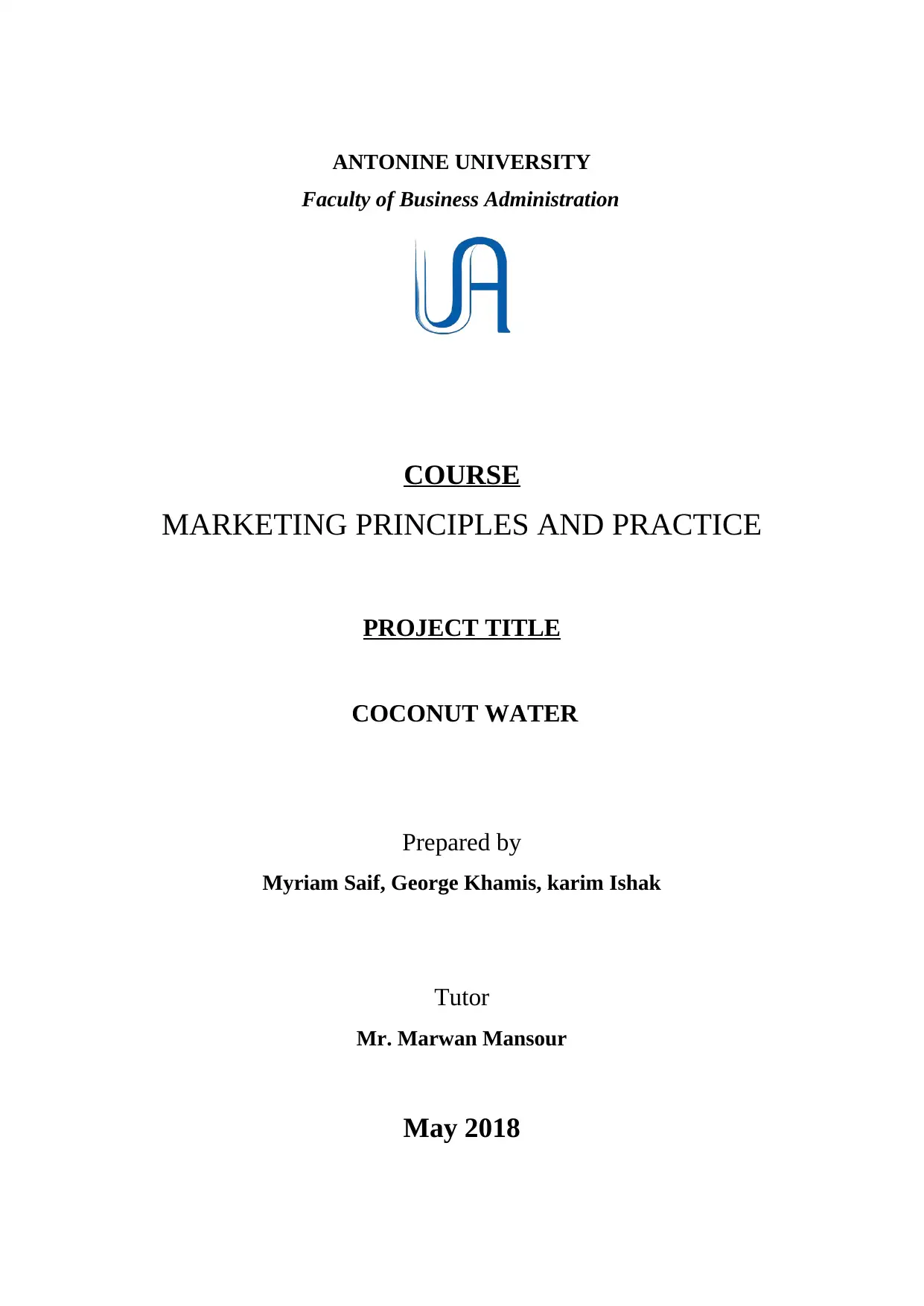
ANTONINE UNIVERSITY
Faculty of Business Administration
COURSE
MARKETING PRINCIPLES AND PRACTICE
PROJECT TITLE
COCONUT WATER
Prepared by
Myriam Saif, George Khamis, karim Ishak
Tutor
Mr. Marwan Mansour
May 2018
Faculty of Business Administration
COURSE
MARKETING PRINCIPLES AND PRACTICE
PROJECT TITLE
COCONUT WATER
Prepared by
Myriam Saif, George Khamis, karim Ishak
Tutor
Mr. Marwan Mansour
May 2018
Secure Best Marks with AI Grader
Need help grading? Try our AI Grader for instant feedback on your assignments.
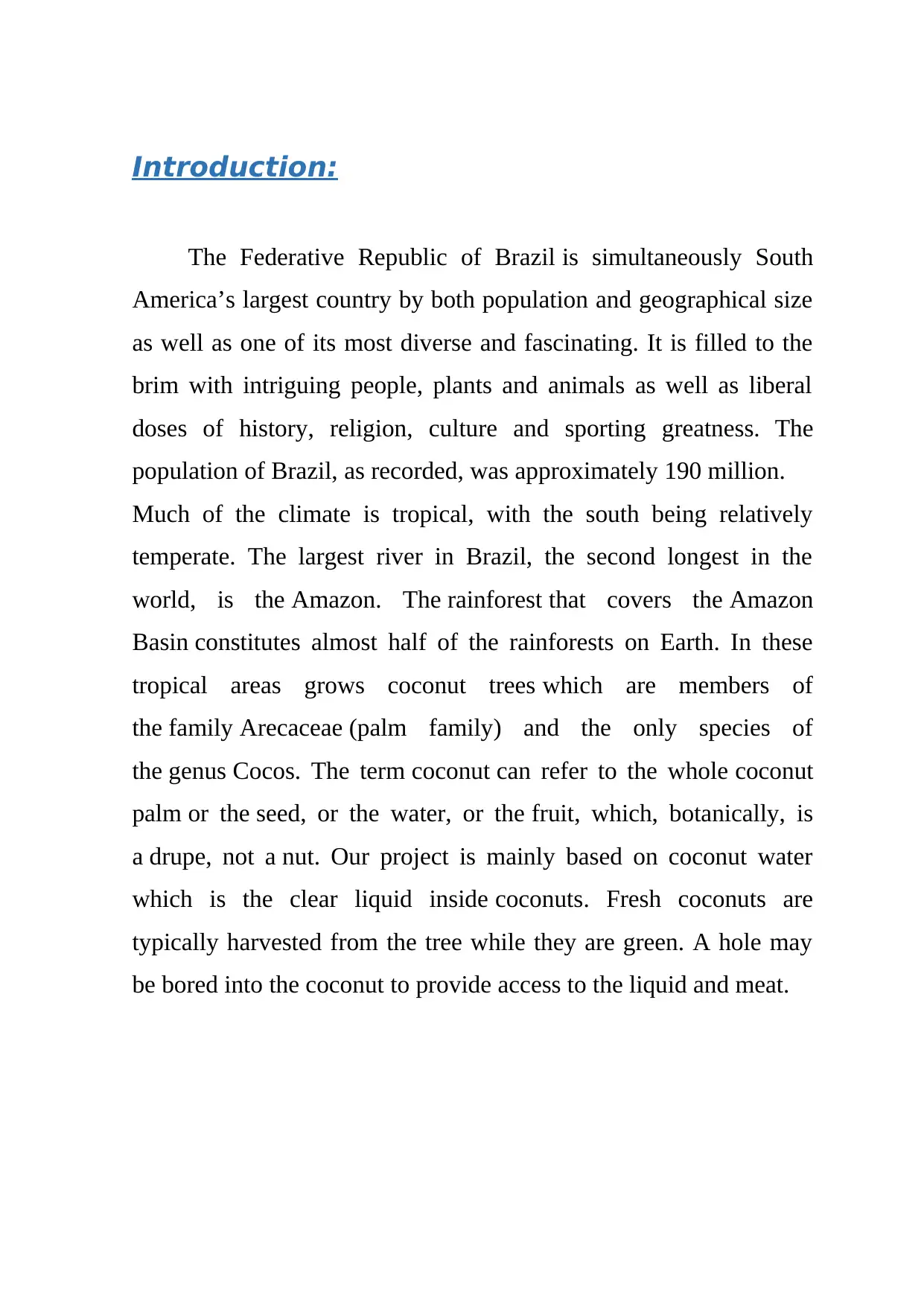
Introduction:
The Federative Republic of Brazil is simultaneously South
America’s largest country by both population and geographical size
as well as one of its most diverse and fascinating. It is filled to the
brim with intriguing people, plants and animals as well as liberal
doses of history, religion, culture and sporting greatness. The
population of Brazil, as recorded, was approximately 190 million.
Much of the climate is tropical, with the south being relatively
temperate. The largest river in Brazil, the second longest in the
world, is the Amazon. The rainforest that covers the Amazon
Basin constitutes almost half of the rainforests on Earth. In these
tropical areas grows coconut trees which are members of
the family Arecaceae (palm family) and the only species of
the genus Cocos. The term coconut can refer to the whole coconut
palm or the seed, or the water, or the fruit, which, botanically, is
a drupe, not a nut. Our project is mainly based on coconut water
which is the clear liquid inside coconuts. Fresh coconuts are
typically harvested from the tree while they are green. A hole may
be bored into the coconut to provide access to the liquid and meat.
The Federative Republic of Brazil is simultaneously South
America’s largest country by both population and geographical size
as well as one of its most diverse and fascinating. It is filled to the
brim with intriguing people, plants and animals as well as liberal
doses of history, religion, culture and sporting greatness. The
population of Brazil, as recorded, was approximately 190 million.
Much of the climate is tropical, with the south being relatively
temperate. The largest river in Brazil, the second longest in the
world, is the Amazon. The rainforest that covers the Amazon
Basin constitutes almost half of the rainforests on Earth. In these
tropical areas grows coconut trees which are members of
the family Arecaceae (palm family) and the only species of
the genus Cocos. The term coconut can refer to the whole coconut
palm or the seed, or the water, or the fruit, which, botanically, is
a drupe, not a nut. Our project is mainly based on coconut water
which is the clear liquid inside coconuts. Fresh coconuts are
typically harvested from the tree while they are green. A hole may
be bored into the coconut to provide access to the liquid and meat.
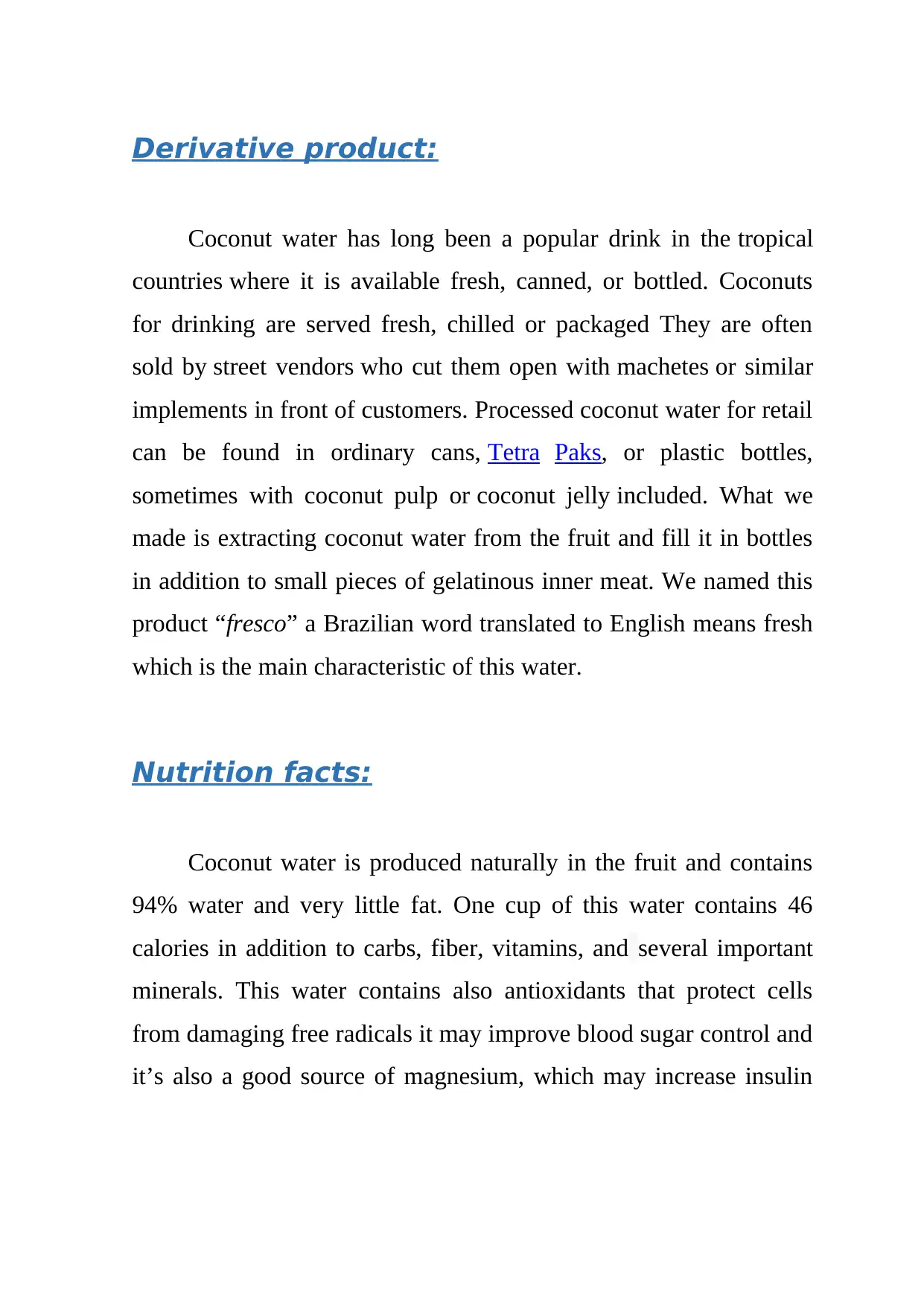
Derivative product:
Coconut water has long been a popular drink in the tropical
countries where it is available fresh, canned, or bottled. Coconuts
for drinking are served fresh, chilled or packaged They are often
sold by street vendors who cut them open with machetes or similar
implements in front of customers. Processed coconut water for retail
can be found in ordinary cans, Tetra Paks, or plastic bottles,
sometimes with coconut pulp or coconut jelly included. What we
made is extracting coconut water from the fruit and fill it in bottles
in addition to small pieces of gelatinous inner meat. We named this
product “fresco” a Brazilian word translated to English means fresh
which is the main characteristic of this water.
Nutrition facts:
Coconut water is produced naturally in the fruit and contains
94% water and very little fat. One cup of this water contains 46
calories in addition to carbs, fiber, vitamins, and several important
minerals. This water contains also antioxidants that protect cells
from damaging free radicals it may improve blood sugar control and
it’s also a good source of magnesium, which may increase insulin
Coconut water has long been a popular drink in the tropical
countries where it is available fresh, canned, or bottled. Coconuts
for drinking are served fresh, chilled or packaged They are often
sold by street vendors who cut them open with machetes or similar
implements in front of customers. Processed coconut water for retail
can be found in ordinary cans, Tetra Paks, or plastic bottles,
sometimes with coconut pulp or coconut jelly included. What we
made is extracting coconut water from the fruit and fill it in bottles
in addition to small pieces of gelatinous inner meat. We named this
product “fresco” a Brazilian word translated to English means fresh
which is the main characteristic of this water.
Nutrition facts:
Coconut water is produced naturally in the fruit and contains
94% water and very little fat. One cup of this water contains 46
calories in addition to carbs, fiber, vitamins, and several important
minerals. This water contains also antioxidants that protect cells
from damaging free radicals it may improve blood sugar control and
it’s also a good source of magnesium, which may increase insulin
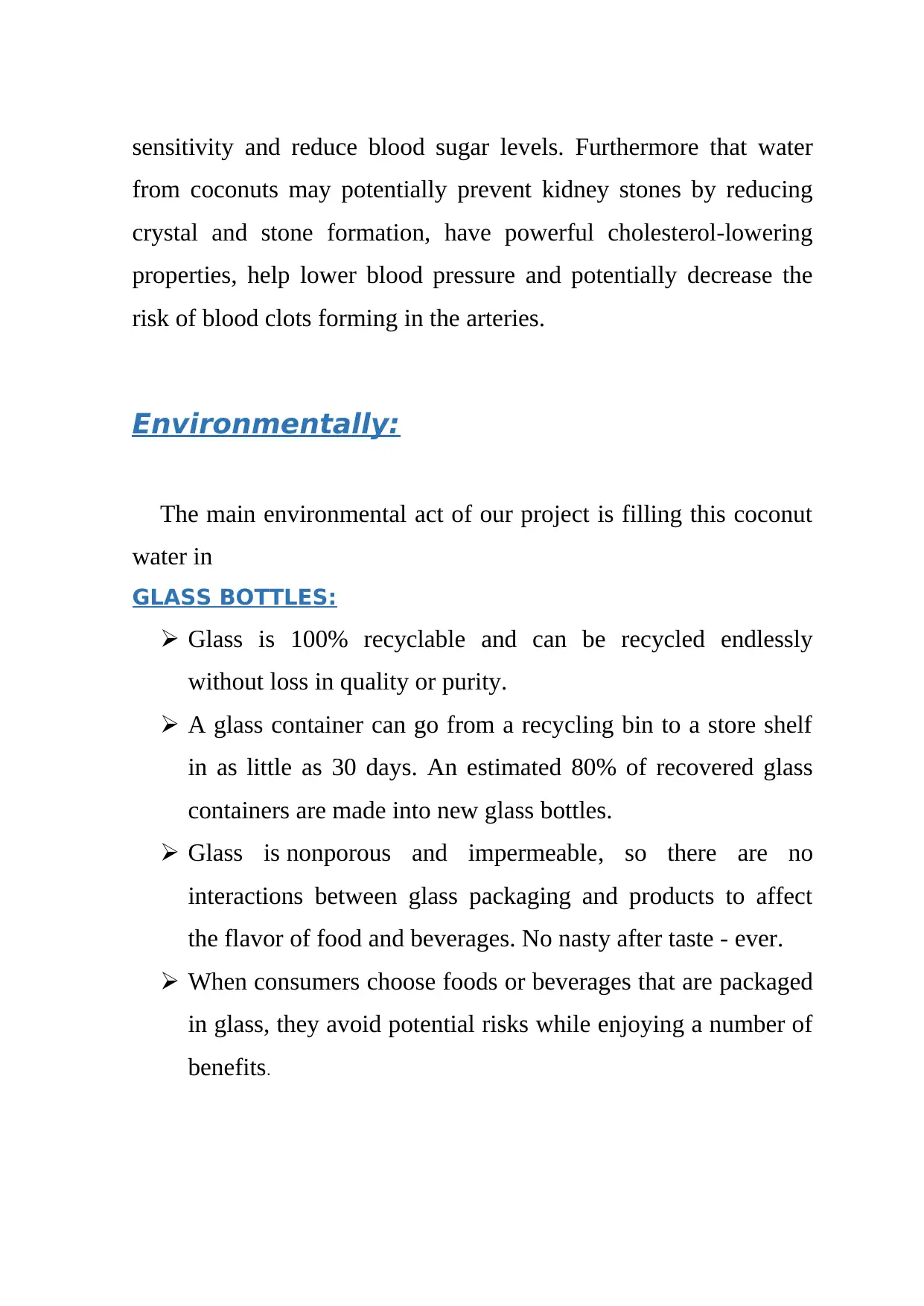
sensitivity and reduce blood sugar levels. Furthermore that water
from coconuts may potentially prevent kidney stones by reducing
crystal and stone formation, have powerful cholesterol-lowering
properties, help lower blood pressure and potentially decrease the
risk of blood clots forming in the arteries.
Environmentally:
The main environmental act of our project is filling this coconut
water in
GLASS BOTTLES:
Glass is 100% recyclable and can be recycled endlessly
without loss in quality or purity.
A glass container can go from a recycling bin to a store shelf
in as little as 30 days. An estimated 80% of recovered glass
containers are made into new glass bottles.
Glass is nonporous and impermeable, so there are no
interactions between glass packaging and products to affect
the flavor of food and beverages. No nasty after taste - ever.
When consumers choose foods or beverages that are packaged
in glass, they avoid potential risks while enjoying a number of
benefits.
from coconuts may potentially prevent kidney stones by reducing
crystal and stone formation, have powerful cholesterol-lowering
properties, help lower blood pressure and potentially decrease the
risk of blood clots forming in the arteries.
Environmentally:
The main environmental act of our project is filling this coconut
water in
GLASS BOTTLES:
Glass is 100% recyclable and can be recycled endlessly
without loss in quality or purity.
A glass container can go from a recycling bin to a store shelf
in as little as 30 days. An estimated 80% of recovered glass
containers are made into new glass bottles.
Glass is nonporous and impermeable, so there are no
interactions between glass packaging and products to affect
the flavor of food and beverages. No nasty after taste - ever.
When consumers choose foods or beverages that are packaged
in glass, they avoid potential risks while enjoying a number of
benefits.
Secure Best Marks with AI Grader
Need help grading? Try our AI Grader for instant feedback on your assignments.
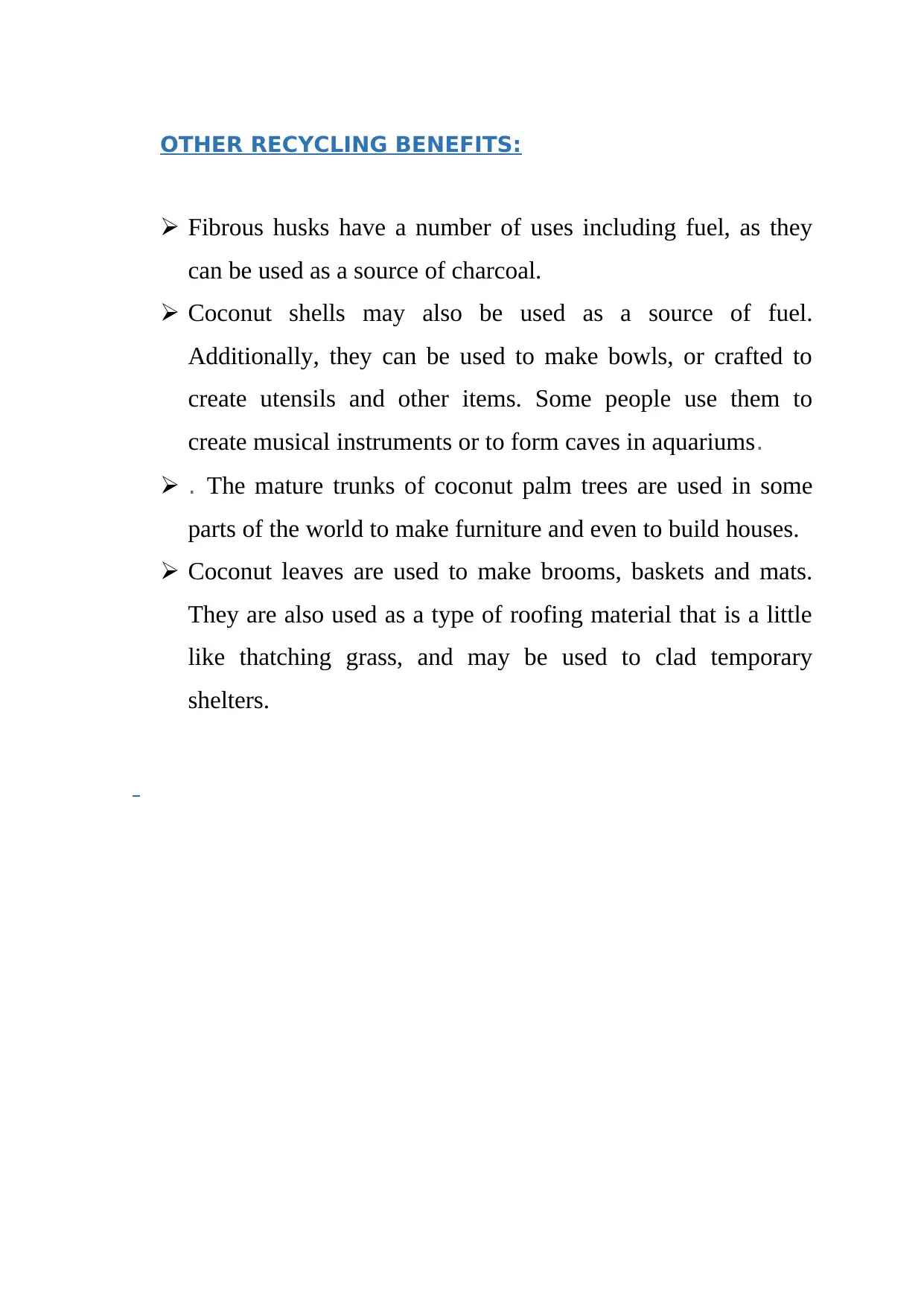
OTHER RECYCLING BENEFITS:
Fibrous husks have a number of uses including fuel, as they
can be used as a source of charcoal.
Coconut shells may also be used as a source of fuel.
Additionally, they can be used to make bowls, or crafted to
create utensils and other items. Some people use them to
create musical instruments or to form caves in aquariums.
. The mature trunks of coconut palm trees are used in some
parts of the world to make furniture and even to build houses.
Coconut leaves are used to make brooms, baskets and mats.
They are also used as a type of roofing material that is a little
like thatching grass, and may be used to clad temporary
shelters.
Fibrous husks have a number of uses including fuel, as they
can be used as a source of charcoal.
Coconut shells may also be used as a source of fuel.
Additionally, they can be used to make bowls, or crafted to
create utensils and other items. Some people use them to
create musical instruments or to form caves in aquariums.
. The mature trunks of coconut palm trees are used in some
parts of the world to make furniture and even to build houses.
Coconut leaves are used to make brooms, baskets and mats.
They are also used as a type of roofing material that is a little
like thatching grass, and may be used to clad temporary
shelters.
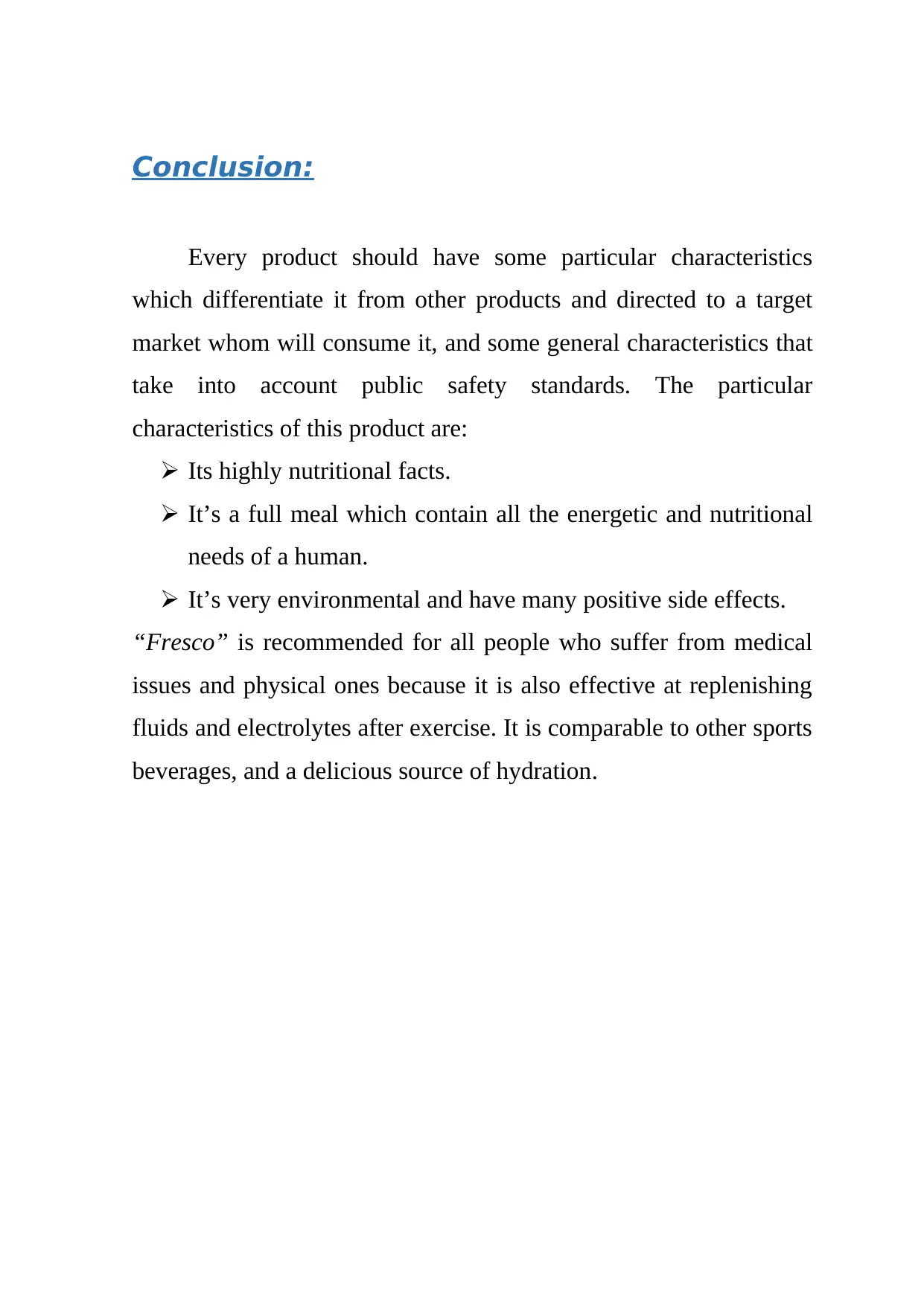
Conclusion:
Every product should have some particular characteristics
which differentiate it from other products and directed to a target
market whom will consume it, and some general characteristics that
take into account public safety standards. The particular
characteristics of this product are:
Its highly nutritional facts.
It’s a full meal which contain all the energetic and nutritional
needs of a human.
It’s very environmental and have many positive side effects.
“Fresco” is recommended for all people who suffer from medical
issues and physical ones because it is also effective at replenishing
fluids and electrolytes after exercise. It is comparable to other sports
beverages, and a delicious source of hydration.
Every product should have some particular characteristics
which differentiate it from other products and directed to a target
market whom will consume it, and some general characteristics that
take into account public safety standards. The particular
characteristics of this product are:
Its highly nutritional facts.
It’s a full meal which contain all the energetic and nutritional
needs of a human.
It’s very environmental and have many positive side effects.
“Fresco” is recommended for all people who suffer from medical
issues and physical ones because it is also effective at replenishing
fluids and electrolytes after exercise. It is comparable to other sports
beverages, and a delicious source of hydration.
1 out of 6
Your All-in-One AI-Powered Toolkit for Academic Success.
+13062052269
info@desklib.com
Available 24*7 on WhatsApp / Email
![[object Object]](/_next/static/media/star-bottom.7253800d.svg)
Unlock your academic potential
© 2024 | Zucol Services PVT LTD | All rights reserved.